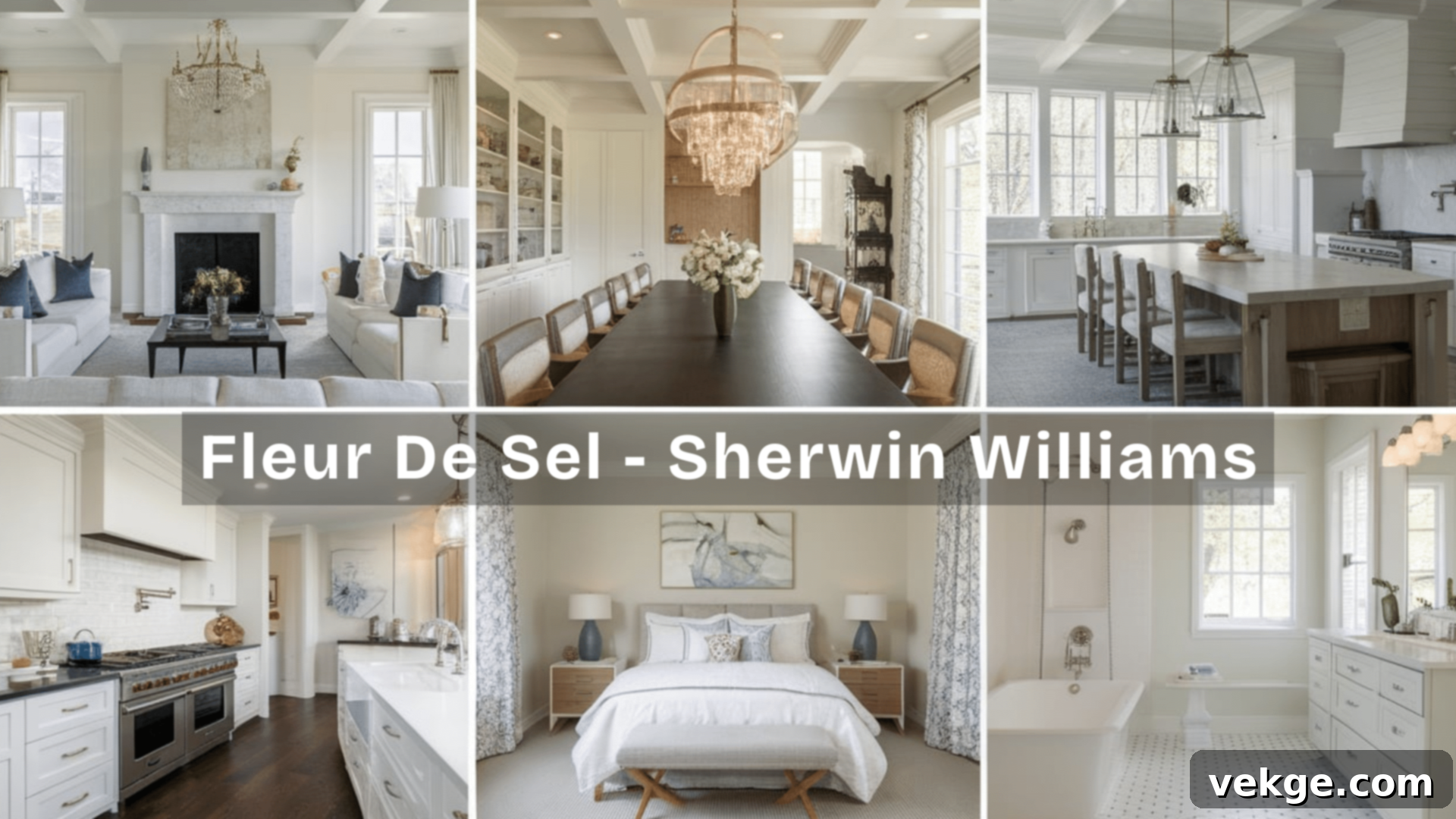Sherwin-Williams Fleur de Sel: The Ultimate Guide to This Versatile Greige Paint for Your Home
Are you on the hunt for that elusive paint color that effortlessly harmonizes with every room in your home? A shade that offers warmth, sophistication, and adaptability without demanding constant redecoration? Many homeowners face the challenge of finding a single, cohesive color that flows beautifully from one space to the next, creating a unified and inviting atmosphere.
Look no further than Sherwin-Williams Fleur de Sel (SW 7666). This remarkably versatile neutral might just be the answer you’ve been searching for. It’s a soft, delicate shade that brings a subtle touch of elegance and comfort to any space, enhancing your existing decor rather than overpowering it.
In this comprehensive guide, we’ll dive deep into everything you need to know about this popular and often-praised paint choice. You’ll discover how Fleur de Sel adapts to different rooms and shifts beautifully under various lighting conditions throughout the day. We’ll also reveal the best complementary colors and textures that make this unique shade truly shine, helping you unlock its full potential in your own home. Let’s begin by exploring what gives Fleur de Sel its special character.
Understanding Sherwin-Williams’ Fleur de Sel (SW 7666): A Chameleonic Neutral
Sherwin-Williams Fleur de Sel (SW 7666) is not just another white or gray; it’s a sophisticated “greige” that masterfully balances warm and cool tones. This soft white paint color emanates a gentle, cozy ambiance without ever appearing overly bright, stark, or cold. It transforms plain walls into inviting, tranquil spaces that feel clean, contemporary, and exceptionally livable from morning till night.
What truly sets Fleur de Sel apart are its subtle greige undertones. These nuanced hints of gray and beige prevent it from feeling flat or sterile, providing just the right amount of warmth to ensure it never reads as a cold, stark white. These undertones are key to its “chameleonic” quality, allowing the color to subtly shift and adapt with the changing light throughout the day, ensuring it always feels natural and perfectly at home.
In bright daylight, Fleur de Sel presents itself as a crisp, clean off-white with cool gray notes. As the day progresses and the light softens, particularly in the afternoon or under warmer artificial lighting, its beige undertones become more prominent, revealing a cozy warmth. This dynamic interplay makes it incredibly adaptable and prevents it from ever feeling dull, a common pitfall for many light neutrals.
Color Terminology for Sherwin-Williams Fleur de Sel:
| PROPERTY | VALUE |
|---|---|
| LRV (Light Reflectance Value) | 72 |
| RGB (Red, Green, Blue) | 220 / 221 / 216 |
| HEX (Hexadecimal) | #DCDDD8 |
What the LRV means: With an LRV of 72, Fleur de Sel sits comfortably in the light-to-mid-range category, meaning it reflects a significant amount of light. This high LRV contributes to its ability to make spaces feel more open, airy, and brighter, an ideal quality for smaller rooms or areas with limited natural light. It’s bright enough to feel fresh but grounded enough by its undertones to avoid blinding glare.
How to Seamlessly Integrate Sherwin-Williams Fleur de Sel into Different Spaces
Fleur de Sel’s unique ability to adapt makes it a powerhouse color for whole-home schemes. It works beautifully across various rooms, shifting from a clean, bright off-white with cool gray hints in morning light to warmer, softer tones as the afternoon sun streams in. This versatile shade is particularly adept at opening up smaller spaces due to its light-reflecting qualities and pairs well with both warm and cool accent colors. The secret to its success in any given room lies in understanding how natural and artificial lighting conditions interact with its subtle greige undertones.
1. Using Fleur de Sel in Living Rooms: Creating an Open and Inviting Hub
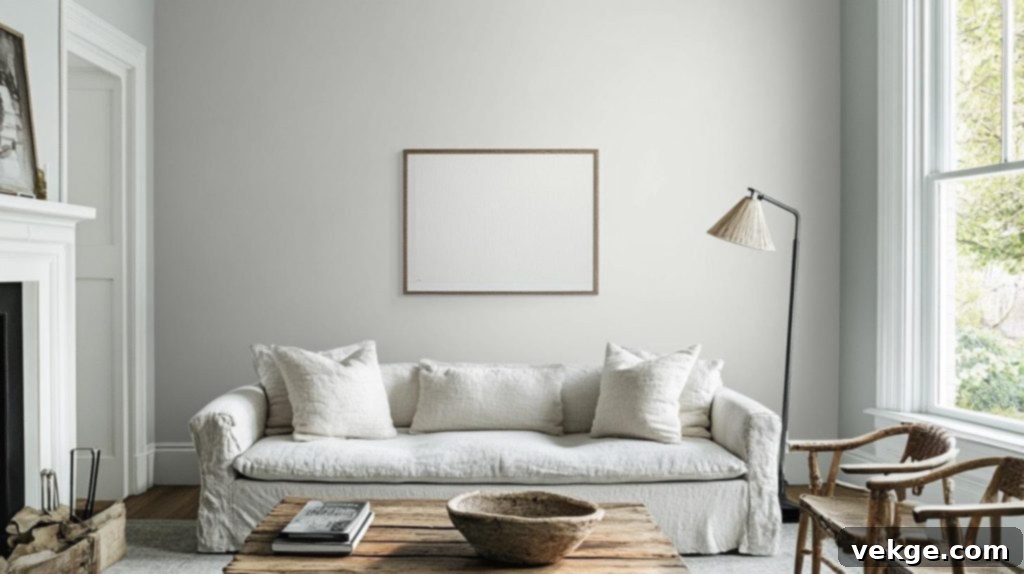
In living spaces, Fleur de Sel excels at creating an airy and expansive feel. It serves as an exceptional backdrop for various decor styles, from modern farmhouse to transitional. When paired with rich, dark brown leather furniture and crisp white trim, it provides a striking yet balanced contrast that feels both sophisticated and welcoming. This color is particularly effective in smaller living rooms (around 15×12 feet or similar dimensions), where its light-reflecting properties can make the space appear significantly larger and more open than it actually is.
To truly appreciate its versatility, it’s recommended to test Fleur de Sel on different walls within your living room. Observe how it performs on window-facing walls, where it might appear brighter and cooler, versus darker corners or walls that receive less direct light, where its subtle warmth may come forward. This comprehensive testing ensures the color maintains its inviting quality consistently throughout the entire room, adapting beautifully to your living room’s unique lighting conditions.
2. Fleur de Sel in Bedrooms: Cultivating a Restful Sanctuary
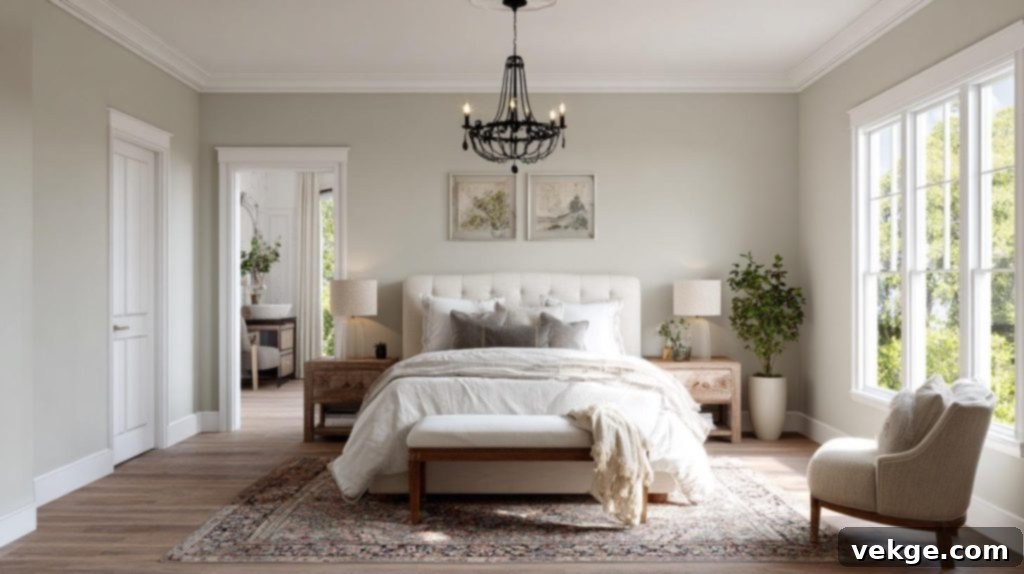
Bedrooms are prime candidates for Fleur de Sel, especially those facing north. In these spaces, where natural light tends to be cooler and more subdued, Fleur de Sel embraces these cooler tones, creating an exceptionally restful and serene environment. It avoids the harshness that many bright whites can exhibit in northern light, instead offering a soft, tranquil backdrop perfect for relaxation and sleep.
To enhance this calming effect, consider pairing Fleur de Sel walls with crisp white bedding, which creates a clean, luxurious contrast. Accents in navy blue or other deep, muted blues can complement the wall color beautifully, adding depth and a touch of sophistication without overwhelming the peaceful ambiance. Sheer white curtains are another excellent choice, working in harmony with Fleur de Sel to filter morning light into a gentle, soft glow rather than an abrupt burst. This thoughtful combination of color and texture helps to create a bedroom that feels like a true escape.
3. Using Fleur de Sel in Kitchens and Dining Areas: Functional Elegance
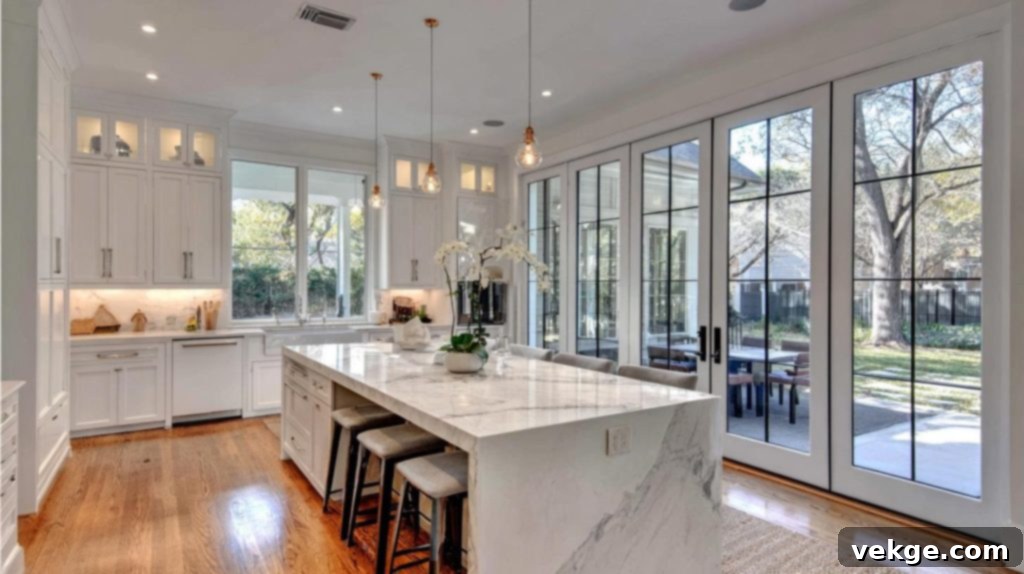
In kitchens and dining areas, Fleur de Sel provides a clean, sophisticated, and highly functional backdrop. When painted alongside classic white cabinets, it offers a subtle yet distinct contrast that prevents the space from feeling too stark or sterile, injecting just the right amount of warmth. This harmonious balance makes it an ideal choice for both traditional and modern kitchen designs. The color also coordinates exceptionally well with a variety of finishes, from sleek stainless steel appliances to the rich, inviting warmth of brass hardware, allowing for diverse styling options.
For kitchen environments, durability is key. Opting for a pearl or satin finish is highly recommended over an eggshell finish, as it offers better resistance to moisture, splashes, and frequent cleaning, ensuring your walls remain pristine. In spaces with limited natural light, consider installing under-cabinet lighting or other strategic task and accent lighting. Thoughtful lighting will not only illuminate your workspace but also beautifully showcase Fleur de Sel’s subtle undertones, bringing out its full character and preventing it from appearing flat.
Remember, good lighting makes a significant difference with this color. If your space doesn’t receive much natural light, planning your artificial lighting before making your final paint decision will help you maximize the paint’s potential and ensure it looks its best.
Pairing Sherwin-Williams Fleur de Sel with Other Colors and Textures
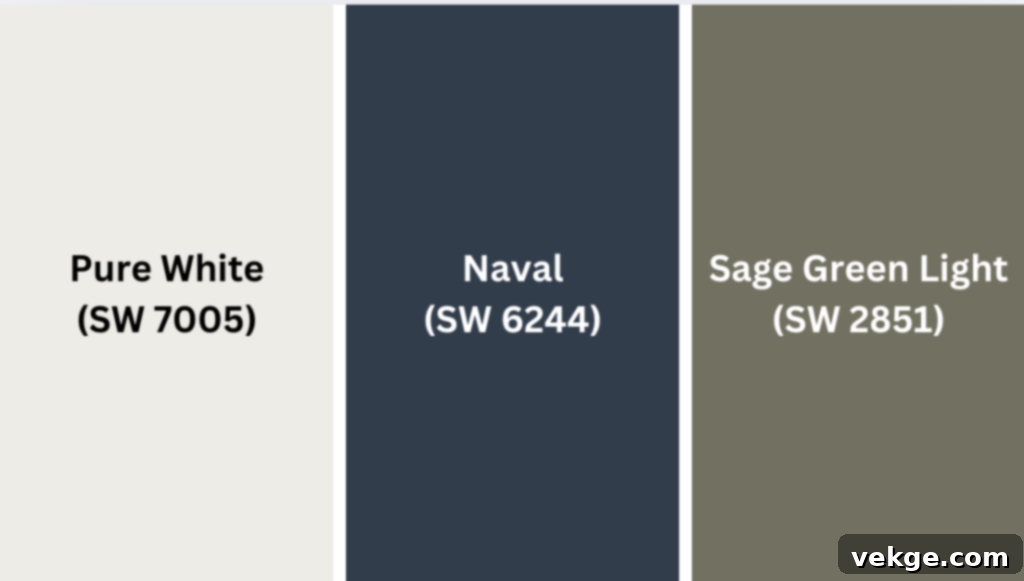
One of Fleur de Sel’s most compelling attributes is its ability to serve as a harmonious base for a vast array of color palettes, effortlessly working with both warm and cool tones to evoke different moods. This flexible paint color beautifully complements rich wood tones and creates crisp, clean lines when paired with bright white trim. Here are some of the best complementary colors that make Fleur de Sel truly sing:
- Pure White (SW 7005): This classic white creates a crisp, clean contrast that feels fresh and bright without being harsh. It’s perfect for trim, ceilings, or accent furniture, allowing Fleur de Sel’s subtle complexity to truly emerge.
- Naval (SW 6244): A deep, sophisticated navy blue, Naval adds significant depth and drama while ensuring the overall space remains light and open. It creates a timeless nautical or elegant backdrop, especially effective in accent walls or furnishings.
- Sage Green Light (SW 2851): This muted, calming sage green beautifully brings out the softer, earthier undertones in Fleur de Sel. It’s ideal for creating a tranquil, nature-inspired palette, perfect for bedrooms or cozy nooks.
- Warm Wood Tones: Dark walnut floors provide a rich, grounding base that beautifully anchors a space with Fleur de Sel walls. Lighter woods like natural oak or birch also pair well, contributing to a Scandinavian or minimalist aesthetic.
- Black Accents: Introduce matte black metal chairs, light fixtures, or picture frames for a modern, striking contrast that defines edges and adds a contemporary edge.
- Muted Earth Tones: Consider terracotta, blush pinks, or soft greys in decor items to lean into Fleur de Sel’s warmer side, creating an inviting and organic feel.
Beyond paint colors, Fleur de Sel enhances metallic accents like brass picture frames and aged bronze light fixtures, making them look even more stylish and intentional against its subtle backdrop. Black and white photographs create a striking, sophisticated contrast, while watercolor prints in soft blues and greens blend seamlessly, reinforcing a calm and cohesive palette.
Creating a Balanced Look with Fleur de Sel and Textures
The most important lesson in designing with Fleur de Sel is understanding how varied textures can elevate its versatility and add layers of interest to a room. In an entryway, for instance, Fleur de Sel walls can be beautifully complemented by a natural jute rug and woven basket storage. The rough, organic textures introduce warmth and prevent the space from feeling overly formal or stark, creating an immediate sense of welcome.
A particularly striking combination unfolds in dining rooms, where matte black metal chairs juxtaposed with a raw wood table create a dynamic interplay of materials. The contrast between the smooth, subtly painted walls and these varied, tactile textures generates a depth that shifts and evolves with the changing light throughout the day, offering constant visual interest.
Similarly, a chunky knit throw in a creamy off-white or light gray draped over a living room sofa makes its plush texture stand out beautifully against the subtle sophistication of the wall color. Incorporating materials like linen, wool, ceramic, and even greenery can further enrich the sensory experience of a room painted with Fleur de Sel, ensuring it always feels rich and inviting.
Expert Tip: Don’t hesitate to mix metal finishes when using Fleur de Sel. Its neutral base acts as a fantastic mediator, allowing brushed nickel, matte black, and warm brass finishes to coexist harmoniously. This approach adds character and depth without making a space feel cluttered or disjointed.
Benefits of Choosing Sherwin-Williams Fleur de Sel (SW 7666)
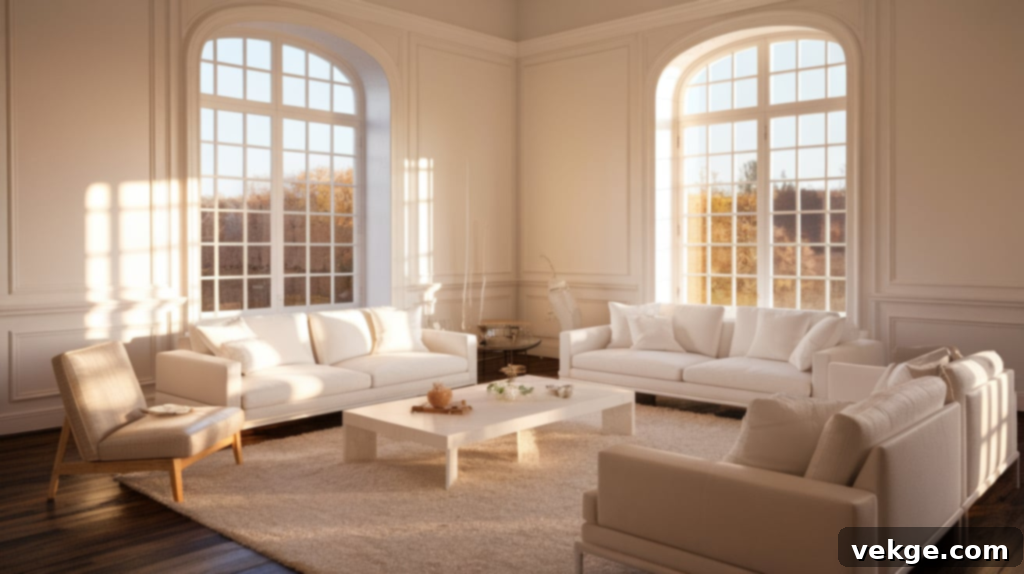
Sherwin-Williams Fleur de Sel (7666) offers a multitude of advantages that make it a compelling choice for homeowners. Its subtle complexity and adaptability contribute to a variety of aesthetic and practical benefits across different design applications.
1. Lightening Up Small or Dark Spaces
Fleur de Sel is a magician in challenging areas like narrow hallways or rooms with minimal natural light. Its high LRV (Light Reflectance Value) means it actively bounces light around the room, making small spaces feel significantly more expansive and open. In a cramped home office or a north-facing room, this paint color works diligently, catching even the smallest amount of available light and diffusing it evenly. Unlike many cool grays that can appear dull and flat in shadow, Fleur de Sel maintains its soft, inviting glow, even in darker corners. Strategic placement of simple white lamps or mirrors can further amplify this light-bouncing effect, creating an illusion of greater space and brightness.
2. Timeless and Versatile Design: A Foundation for Any Style
One of Fleur de Sel’s most cherished qualities is its remarkable timelessness and versatility. This color effortlessly adapts to a vast array of decorating styles – from the rustic charm of modern farmhouse to the sleek lines of contemporary, the relaxed vibe of coastal, or the sophisticated appeal of traditional decor – without ever feeling quickly dated. Its subtle greige undertones allow it to act as a perfect neutral chameleon, complementing both vibrant accents like bright coral pillows and muted tones such as deep green ones with equal grace. Even cherished antique wooden furniture looks natural and enhanced against these walls. This inherent adaptability not only ensures a long-lasting aesthetic appeal but also offers practical savings, as repainting isn’t necessary when you decide to update your decor and furnishings.
3. How Fleur de Sel Enhances Natural Light: A Seasonal & Daily Spectacle
Fleur de Sel truly comes alive under the influence of natural light, showcasing its multifaceted personality throughout the day and across the seasons. In south-facing kitchens, the morning sun gently brings out its soft, warm notes, creating an inviting glow. As the day progresses, the afternoon light introduces cooler tones, keeping spaces feeling fresh and balanced. Even on overcast days, rooms painted with Fleur de Sel resist feeling gloomy, a common issue with other light colors. During the brighter summer months, it maintains a cool and refreshing quality, while the lower, warmer light of winter subtly highlights its inherent warmth. To complement its natural adaptability, use LED bulbs with a 3000K temperature for a warm, natural glow, or 3500K for a slightly crisper, yet still natural, feel. An eggshell finish is excellent for reflecting light while subtly masking imperfections, making it ideal for living areas. For moisture-prone areas like bathrooms, a pearl or satin finish is recommended for better durability and cleanability.
4. Classic and Traditional Spaces with Fleur de Sel: Elegant Understatement
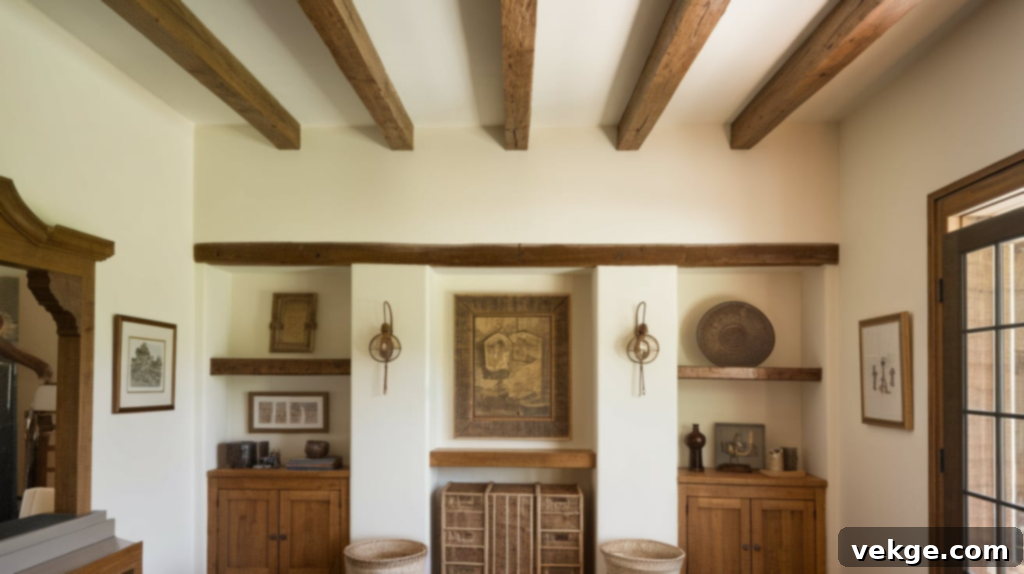
Fleur de Sel proves its mettle even in classic and traditional settings. Imagine a formal dining room where it creates a fresh yet sophisticated backdrop for mahogany dining sets and crystal chandeliers. The color offers enough subtle depth to highlight architectural details like crown molding and wainscoting without competing with them, allowing these classic features to truly shine. Oil paintings in ornate gold frames gain a richer, more distinguished appearance against these walls, their colors appearing more vibrant. Introducing luxurious textiles such as velvet curtains in a deep blue or emerald green can create a perfect balance between timeless elegance and current design trends, showcasing Fleur de Sel’s ability to anchor a gracefully appointed room.
5. Incorporating Fleur de Sel into Modern or Minimalist Rooms: Clean and Focused

For modern or minimalist interiors, Fleur de Sel offers a clean, professional, and understated background. Against white desks, black metal shelving, or sleek, contemporary furniture, it provides enough visual interest to prevent a room from feeling sterile without being distracting. Simple line drawings in black frames, geometric rugs in muted grays and whites, and clean-lined decor become intentional focal points against these walls. Matte black light fixtures and simple white blinds work perfectly to create a focused workspace or a calm, uncluttered living area. The color’s subtle warmth prevents the minimalist aesthetic from feeling cold or impersonal, ensuring a space that is both refined and inviting. To maintain this clean aesthetic, opt for desk accessories in clear glass, white, or light wood tones.
6. Fleur de Sel in Coastal and Farmhouse Styles: Relaxed Charm
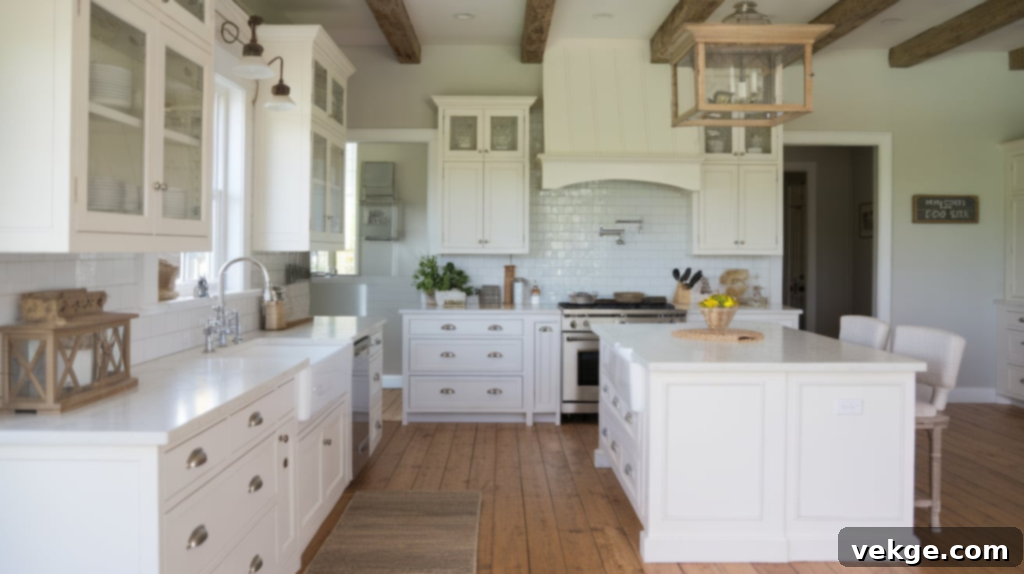
For coastal-inspired retreats, Fleur de Sel provides a perfect foundation. Its soft gray notes evoke the calming hues of a misty seaside, making it ideal for pairing with white shiplap accent walls, natural fiber rugs, and light blue bedding. Woven baskets and organic textures complete the look, transforming a guest bedroom into a peaceful beach cottage. In a modern farmhouse kitchen, Fleur de Sel walls beautifully complement white cabinets, butcher block counters, and distressed wood elements. Black iron hardware and mason jar light fixtures stand out perfectly, creating a cozy yet current aesthetic. Simple botanical prints in wooden frames further enhance the natural, rustic charm.
What’s truly remarkable is how Fleur de Sel adapts its perceived character to support each style. In a sleek modern office, it reads as crisp and clean. In a welcoming farmhouse kitchen, it feels warm and inviting. The key lies in selecting the right accessories and furnishings; the paint color then subtly shifts to match the mood and aesthetic you’ve curated around it, proving its unparalleled adaptability.
How to Sample and Test Fleur de Sel in Your Home: A Crucial Step
Testing Fleur de Sel in your own space is arguably the most critical step before committing to this versatile color. Its nuanced tones will interact uniquely with your home’s specific lighting conditions, existing furniture, and fixed finishes. Taking the time to properly sample and observe the paint will save you from potential disappointment and costly mistakes.
1. Ordering Paint Samples from Sherwin-Williams
When embarking on your color testing journey, acquiring the right samples makes all the difference. Visit your local Sherwin-Williams store to pick up both a sample can and several paint chips. A sample quart in an eggshell finish (which typically costs around $8) is usually sufficient to paint multiple large test squares on different walls without excessive waste. When purchasing, be sure to specify Sherwin-Williams Fleur de Sel (SW 7666). While they can mix it in any finish, eggshell offers the most accurate representation of how the final painted wall will appear, balancing light reflection with subtle texture. Additionally, grab three to five physical paint chips; these can be moved around your house effortlessly at different times of the day to get a quick feel for the color without paint mess.
2. Testing the Color in Different Lighting Conditions
This step is absolutely vital for making an informed decision about Fleur de Sel. Paint three generous 2×2 foot squares on different walls within the room you intend to paint. Choose one wall that receives direct sunlight, another in partial shade, and a third in a darker corner. The most valuable insight comes from observing these test patches throughout the entire day:
- Morning Light (7-10 AM): Typically, the color will appear brightest, and its subtle cool blue or gray undertones may be more prominent.
- Midday (12-2 PM): Under the strongest light, Fleur de Sel will often look its truest to the original paint chip, presenting as a balanced light greige.
- Evening (4-7 PM): As the natural light wanes, the color will likely warm up slightly, with its beige undertones coming forward, creating a cozier and more inviting feel.
- Artificial Light: Don’t forget to test the paint under your various light bulbs. Warmer bulbs (2700K-3000K) will enhance its creamy qualities, while cooler bulbs (4000K+) might emphasize its grayer tones. This observation can guide your choice of light bulbs for each room to achieve your desired ambiance.
3. Using Paint Swatches to Visualize the Color in Your Home
Beyond painting large samples, using smaller paint swatches or larger peel-and-stick samples can offer additional perspective. Tape these swatches next to your existing trim color, against different pieces of furniture, and near your flooring to see how they interact. A helpful trick is to look at the swatch both vertically and horizontally, as the perception of color can subtly change with orientation. Carrying a swatch with you for a week or two can also be beneficial, allowing you to:
- Compare it to new decor items you might be considering.
- Check how it looks next to cabinet colors or built-ins.
- Test it against different flooring options in various rooms.
The most valuable lesson in this process is patience. Live with your painted test patches for at least a full week before making your final decision. This extended observation period allows you to experience the color in every possible light, ensuring you feel completely confident and delighted with your choice. Remember to check the color under both overhead lights and lamps at night, as they can sometimes cast different hues. This thorough testing process is an investment that safeguards against expensive mistakes and leads you to the perfect shade for your home.
How to Maintain Sherwin-Williams Fleur de Sel Paint: Keeping Walls Pristine
Living with Fleur de Sel walls is a joy, and with a few simple maintenance practices, you can ensure they remain looking fresh, clean, and beautiful for years to come. The subtle nature of this color makes it quite forgiving, but regular care will help preserve its delicate charm.
- Use a Mild Cleaner for Regular Cleaning: For routine dusting and removing light smudges, a soft, damp cloth or sponge with a gentle, non-abrasive soap (like mild dish soap diluted in water) is usually sufficient. Wipe gently, avoiding harsh scrubbing, to prevent damaging the paint finish. Always test a small, inconspicuous area first.
- Avoid Harsh Scrubbers and Chemicals: Steer clear of abrasive pads, sponges, or strong chemical cleaners. These can easily dull the paint’s soft finish, create uneven spots, or even remove the paint entirely, especially with matte or eggshell finishes.
- Keep Touch-Up Paint on Hand: It’s always a good idea to save a small amount of your original Fleur de Sel paint for quick touch-ups. Scuffs, minor marks, or small chips, particularly in high-traffic areas like hallways or entryways, can be easily repaired, making your walls look brand new again.
- Dust Regularly: Use a soft duster or a microfiber cloth to regularly dust your walls. This prevents dust and cobwebs from accumulating, which can dull the fresh, light appearance of Fleur de Sel over time.
- Address Stains Promptly: Spills, fingerprints, or other marks should be cleaned as quickly as possible. Fresh stains are much easier to remove than dried-on ones, which can set and become permanent, especially in areas prone to splashes like kitchens or bathrooms.
With just a little consistent care, your Fleur de Sel walls will continue to provide a serene and stylish backdrop for your home, showcasing its beauty day after day.
Conclusion
By now, you have a complete and detailed understanding of the remarkable potential Sherwin-Williams Fleur de Sel (SW 7666) holds for transforming your home. This highly versatile greige neutral proves its worth across all areas, from bustling living rooms and tranquil bedrooms to functional kitchens and inviting dining areas, delivering consistently beautiful results.
You’ve explored its unique greige undertones, learned how it adapts to different lighting conditions, and discovered how it harmonizes with both warm and cool accent colors, allowing you to craft a style that is uniquely yours. From classic elegance to modern minimalism, and coastal to farmhouse charm, Fleur de Sel provides a flawless foundation for any aesthetic.
If you’re considering this exquisite color for your next painting project, remember the golden rule: always begin with a sample. Paint a generous test patch on your wall and meticulously observe it throughout different lighting conditions over several days. This crucial step ensures that Fleur de Sel’s subtle character truly resonates with your home’s unique environment.
As a light-reflecting color, Fleur de Sel is guaranteed to make any room feel more spacious, brighter, and utterly sophisticated. Ready to infuse your home with the understated elegance and captivating versatility of Sherwin-Williams Fleur de Sel? We’d love to hear about your experience and see your transformations in the comments below!
Frequently Asked Questions About Sherwin-Williams Fleur de Sel
What Makes Fleur de Sel Different from Other Gray Paint Colors?
Fleur de Sel distinguishes itself with its balanced greige undertones, which allow it to remain a true neutral in most lighting conditions. Unlike many grays that can lean too blue or too beige, depending on the time of day and natural light, Fleur de Sel maintains its subtle complexity, offering warmth without being overly yellow and coolness without feeling icy.
How Many Coats of Fleur de Sel Do I Need for Optimal Coverage?
Typically, two coats of Fleur de Sel are sufficient to achieve full, even coverage on previously painted walls. If you’re painting over a darker color, you may benefit from a primer coat first, followed by two full coats of Fleur de Sel. Always allow adequate drying time, usually around four hours, between coats for best results.
Does Fleur de Sel Work Well in North-Facing Rooms?
Yes, Fleur de Sel performs exceptionally well in north-facing spaces. Its subtle warmth prevents the color from appearing cold or dull, which can be a common issue with other grays in cooler light. It maintains a soft, inviting look even on overcast days, making north-facing rooms feel cozy and bright rather than gloomy.
What Type of Lighting Works Best with Fleur de Sel?
Lighting with a color temperature between 2700K to 3500K is generally best for Fleur de Sel. Warmer bulbs (2700K-3000K) will enhance its creamy undertones, creating a cozier feel. Natural daylight keeps its truest, most balanced appearance. It’s advisable to avoid cooler bulbs (4000K and above) in residential settings, as they can make the color feel too stark or cool, similar to office lighting.
Can Fleur de Sel Be Used in Small Spaces?
Absolutely. With an LRV of 72, Fleur de Sel is an excellent choice for small rooms. Its high light reflectance brightens and expands tight spaces, making them feel more open and airy. When paired with mirrors, minimalist decor, and soft lighting, it can transform even the smallest room into a calm, inviting oasis without appearing harsh or overwhelming.
